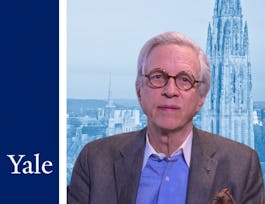This course examines how the idea of "the modern" develops at the end of the 18th century in European philosophy and literature, and how being modern (or progressive, or hip) became one of the crucial criteria for understanding and evaluating cultural change. Are we still in modernity, or have we moved beyond the modern to the postmodern?

New year. Big goals. Bigger savings. Unlock a year of unlimited access to learning with Coursera Plus for $199. Save now.


The Modern and the Postmodern (Part 1)

Instructor: Michael S. Roth
137,842 already enrolled
Included with 
(1,014 reviews)
Details to know

Add to your LinkedIn profile
See how employees at top companies are mastering in-demand skills


Earn a career certificate
Add this credential to your LinkedIn profile, resume, or CV
Share it on social media and in your performance review

There are 8 modules in this course
“The Modern and the Postmodern Part I” covers the first half of a full semester course on European history, literature and philosophy. We begin with Immanuel Kant and Jean Jacques Rousseau and conclude with Friedrich Nietzsche and Charles Baudelaire and a very quick look at painting at the time they wrote. Although in the final week themes of postmodernism begin to emerge, a discussion of how modernism becomes postmodernism is at the heart of Part II of this course.
What's included
2 readings
Why is philosophy relevant to modernity? Through reading Jean-Jacques Rousseau and Immanuel Kant, we examine philosophy as a reflection on modernity and progress.
What's included
2 videos1 reading
Using Rousseau’s Discourse on the Origins of Inequality, we study how the pursuit of knowledge is related to the politics of inequality.
What's included
4 videos1 reading
Karl Marx is our focus here as we move from a consideration of ideas to a confrontation with alienation, class struggle and revolution.
What's included
5 videos1 reading1 peer review
We read Flaubert’s Madame Bovary as a reflection on convention, stupidity and art in the wake of the failures of mid-19th century revolution.
What's included
4 videos1 reading1 peer review
We situate Charles Darwin’s great achievement in the context of the English Enlightenment traditions and reimaging the world without a goal for change.
What's included
4 videos1 reading
Through an examination of Charles Baudelaire and Friedrich Nietzsche, we focus on an aesthetic embrace of intensity instead of search for the “really real.”
What's included
6 videos1 reading1 peer review
A Quick Survey of how advanced painting moved toward a consideration of the surface of the canvas and away from a quest for the most realistic representation of the world.
What's included
2 videos
Instructor

Offered by
Recommended if you're interested in Philosophy

University of Illinois Urbana-Champaign

Yonsei University

Yale University
Why people choose Coursera for their career




Learner reviews
1,014 reviews
- 5 stars
84.25%
- 4 stars
12.10%
- 3 stars
1.96%
- 2 stars
0.59%
- 1 star
1.08%
Showing 3 of 1014
Reviewed on Aug 4, 2021
good course highlighting all the important aspects of the period concisely ,providing detailed information by recommending the necessary material to upgrade your knowledge in depth.
Reviewed on Sep 5, 2015
I've not finished this course yet, but I found it to be excellent, the content is important to understand, the teacher is clear and I enjoy listening to him. I really recommend it.
Reviewed on Dec 28, 2020
Excellent course. The lectures were engaging and very informative and broad with the inclusion of a variety of thinkers. I also appreciated learning about the paintings of the post-modern period.

Open new doors with Coursera Plus
Unlimited access to 10,000+ world-class courses, hands-on projects, and job-ready certificate programs - all included in your subscription
Advance your career with an online degree
Earn a degree from world-class universities - 100% online
Join over 3,400 global companies that choose Coursera for Business
Upskill your employees to excel in the digital economy
Frequently asked questions
Access to lectures and assignments depends on your type of enrollment. If you take a course in audit mode, you will be able to see most course materials for free. To access graded assignments and to earn a Certificate, you will need to purchase the Certificate experience, during or after your audit. If you don't see the audit option:
The course may not offer an audit option. You can try a Free Trial instead, or apply for Financial Aid.
The course may offer 'Full Course, No Certificate' instead. This option lets you see all course materials, submit required assessments, and get a final grade. This also means that you will not be able to purchase a Certificate experience.
When you purchase a Certificate you get access to all course materials, including graded assignments. Upon completing the course, your electronic Certificate will be added to your Accomplishments page - from there, you can print your Certificate or add it to your LinkedIn profile. If you only want to read and view the course content, you can audit the course for free.
You will be eligible for a full refund until two weeks after your payment date, or (for courses that have just launched) until two weeks after the first session of the course begins, whichever is later. You cannot receive a refund once you’ve earned a Course Certificate, even if you complete the course within the two-week refund period. See our full refund policy.


